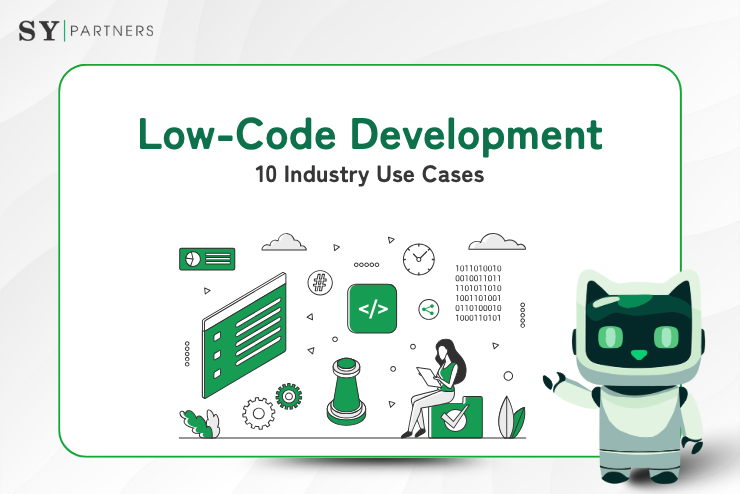10 Promising Use Cases for Low-Code Development Across Industries
Low-code development is rapidly gaining ground across enterprises as a practical approach to accelerate digital transformation. By using intuitive visual interfaces and minimizing the need for traditional programming, platforms like FlutterFlow, Bubble, OutSystems, and Mendix empower organizations to build scalable applications faster and at reduced cost. These platforms enable not only rapid prototyping and MVP launches but also system modernization and integration with legacy infrastructure.
In this article, we explore 10 industry-specific use cases where low-code platforms are driving tangible value by solving real operational challenges. Each case illustrates how low-code tools are being applied strategically to streamline workflows, enhance user experience, and support agile business models.
1. Manufacturing: Real-Time Production Line Management Dashboard
Challenge:
Manufacturers often lack visibility into real-time production and inventory data, leading to frequent downtime and supply shortages. Traditional ERP systems are too rigid to accommodate evolving on-site needs.
Solution:
Develop a real-time dashboard using a low-code platform that aggregates data from IoT sensors into a centralized cloud system. Visualize machine uptime, production bottlenecks, and inventory levels. Empower on-site staff with tablet-based interfaces and connect to ERP systems via custom APIs.
Key Tools:
OutSystems, Azure IoT Hub, Power BI
2. Hospitality & Services: Customer Feedback Collection App
Challenge:
Hotels and restaurants struggle with collecting timely customer feedback, often relying on paper or email-based surveys, leading to low response rates and delayed action.
Solution:
Build a mobile feedback app accessible via QR codes. Customers submit satisfaction ratings and comments instantly. Managers can view responses in real time and take immediate action. CRM integration enables automated campaign follow-ups.
Key Tools:
Bubble, Airtable, Zapier
3. Startups: Rapid SaaS MVP Development
Challenge:
Startups need to validate ideas quickly but lack time and budget for full-code development. Recruiting developers can delay market entry.
Solution:
Use a low-code platform to create an MVP with drag-and-drop UI, Firebase-based backend, and integrated analytics. Custom code modules can be added where differentiation is needed.
Key Tools:
FlutterFlow, Firebase, Google Analytics
4. Logistics: Delivery Tracking System
Challenge:
Delivery tracking is often manual, with data spread across paper and spreadsheets. This results in delayed updates and poor customer experience.
Solution:
Build a delivery tracking app that lets drivers update delivery status via smartphones. GPS integration provides real-time location tracking to customers. APIs ensure seamless sync with logistics management systems.
Key Tools:
Mendix, Google Maps API, Make
5. Education: Learning Management System (LMS)
Challenge:
Universities and vocational schools operate fragmented systems for class schedules, learning materials, and grading—confusing both students and faculty.
Solution:
Create an integrated LMS using low-code, featuring single sign-on (SSO), centralized dashboards for faculty, and self-service portals for students. Integrate with file storage and authentication systems.
Key Tools:
OutSystems, Google Drive, Okta
6. Financial Services: Loan Application Automation
Challenge:
Manual loan processing leads to long wait times, increasing the risk of customer attrition.
Solution:
Design a digital loan application app. Customers can upload documents and complete forms online. Automated validation ensures data accuracy. AI-assisted credit scoring and e-signatures expedite approval.
Key Tools:
Mendix, AWS Lambda (AI), DocuSign
7. Retail: Employee Shift Scheduling App
Challenge:
Managing shift schedules on spreadsheets leads to errors and coordination issues, contributing to staff dissatisfaction and turnover.
Solution:
Develop a mobile-friendly app for managers to publish and adjust schedules. Staff can submit shift preferences and receive real-time notifications. Integration with payroll systems automates timesheet calculations.
Key Tools:
Bubble, Google Calendar, QuickBooks
8. Real Estate: Property Management & Client Portal
Challenge:
Property listings are often managed offline or through Excel, causing delays in client communication and poor customer satisfaction.
Solution:
Build a customer-facing property portal with filtering, virtual tours, and AI-powered matching based on preferences. Agents can update listings directly and respond to inquiries via built-in chat.
Key Tools:
Bubble, Supabase, Algolia
9. Healthcare: Patient Management & Telemedicine Integration
Challenge:
Many clinics still rely on paper records and legacy systems, hampering efforts to deliver efficient telemedicine services.
Solution:
Create a unified patient management system. Patients can schedule appointments, complete digital pre-check forms, and join video consultations. Doctors access dashboards with full medical history.
Key Tools:
OutSystems, Zoom API, Twilio
10. HR: Recruitment Management System
Challenge:
HR teams face inefficiencies in handling job postings, candidate tracking, and interview scheduling, often using disconnected systems.
Solution:
Build a recruitment platform that allows HR to publish job listings, collect applications, and automate interview scheduling. AI filters resumes and candidates can check progress via a personalized portal.
Key Tools:
Mendix, Workable, Make
Summary
Low-code platforms are reshaping enterprise development strategies across sectors including manufacturing, logistics, healthcare, and HR. By accelerating delivery cycles, reducing development costs, and enabling greater participation from non-technical users, low-code empowers organizations to drive innovation and agility.
To ensure success, enterprises should:
- Clearly define business objectives and user needs
- Select platforms that align with their IT governance and scalability requirements
- Start with small-scale pilots before scaling organization-wide
Leveraging low-code as a core part of digital transformation can unlock sustainable value and position your organization for competitive advantage.
FAQs
- Q1: Who should use low-code platforms?
- Suitable for startups, SMEs, and large enterprises aiming for fast development, process optimization, or legacy modernization.
- Q2: Difference between low-code and no-code?
- Low-code allows limited coding and more customization. No-code targets simpler use cases with visual-only development.
- Q3: Is low-code scalable?
- With proper backend (e.g., Firebase) and optimization, it supports high traffic. For extreme loads, custom development may be required.
- Q4: Are there security concerns?
- Yes, but leading platforms offer enterprise-grade security features. Organizations should align with regulations and internal policies.
- Q5: Can low-code apps integrate with other systems?
- Yes, through APIs, webhooks, and integration tools like Zapier or Make, supporting seamless workflows across platforms.


 EN
EN JP
JP KR
KR




